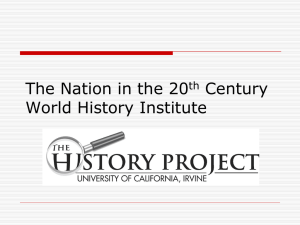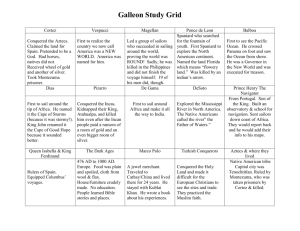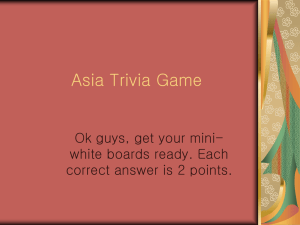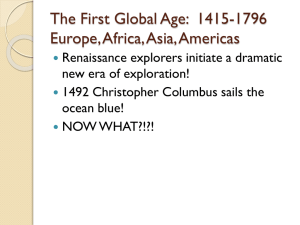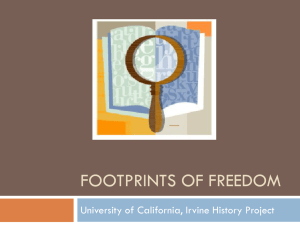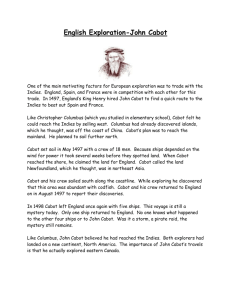Exploring
advertisement
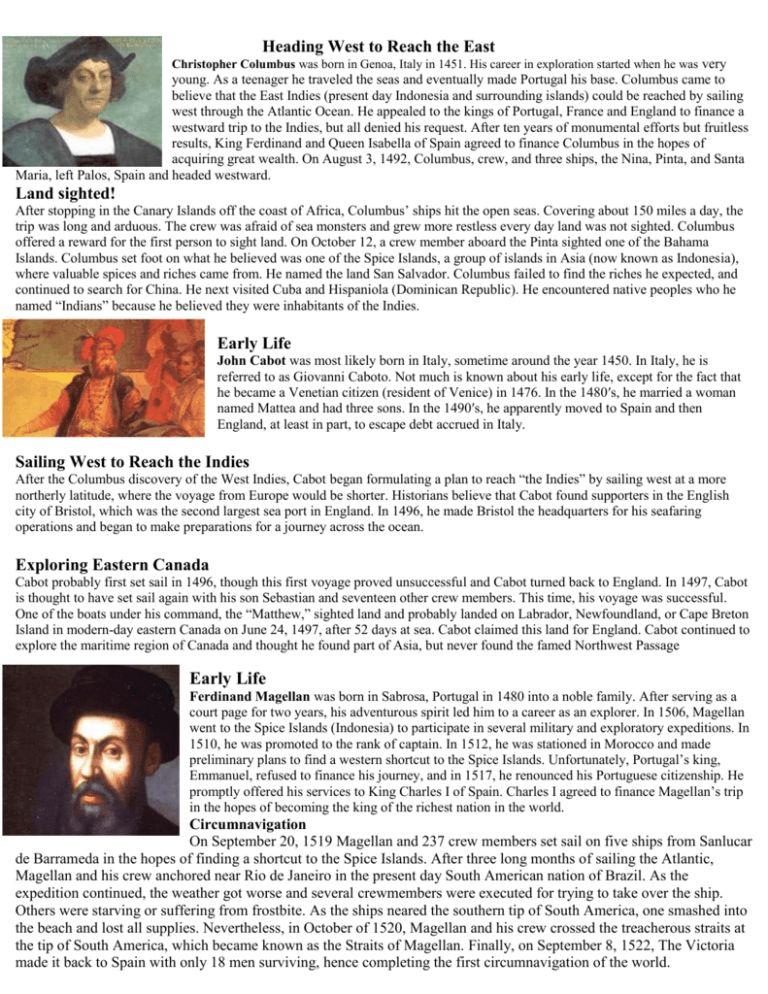
Heading West to Reach the East Christopher Columbus was born in Genoa, Italy in 1451. His career in exploration started when he was very young. As a teenager he traveled the seas and eventually made Portugal his base. Columbus came to believe that the East Indies (present day Indonesia and surrounding islands) could be reached by sailing west through the Atlantic Ocean. He appealed to the kings of Portugal, France and England to finance a westward trip to the Indies, but all denied his request. After ten years of monumental efforts but fruitless results, King Ferdinand and Queen Isabella of Spain agreed to finance Columbus in the hopes of acquiring great wealth. On August 3, 1492, Columbus, crew, and three ships, the Nina, Pinta, and Santa Maria, left Palos, Spain and headed westward. Land sighted! After stopping in the Canary Islands off the coast of Africa, Columbus’ ships hit the open seas. Covering about 150 miles a day, the trip was long and arduous. The crew was afraid of sea monsters and grew more restless every day land was not sighted. Columbus offered a reward for the first person to sight land. On October 12, a crew member aboard the Pinta sighted one of the Bahama Islands. Columbus set foot on what he believed was one of the Spice Islands, a group of islands in Asia (now known as Indonesia), where valuable spices and riches came from. He named the land San Salvador. Columbus failed to find the riches he expected, and continued to search for China. He next visited Cuba and Hispaniola (Dominican Republic). He encountered native peoples who he named “Indians” because he believed they were inhabitants of the Indies. Early Life John Cabot was most likely born in Italy, sometime around the year 1450. In Italy, he is referred to as Giovanni Caboto. Not much is known about his early life, except for the fact that he became a Venetian citizen (resident of Venice) in 1476. In the 1480′s, he married a woman named Mattea and had three sons. In the 1490′s, he apparently moved to Spain and then England, at least in part, to escape debt accrued in Italy. Sailing West to Reach the Indies After the Columbus discovery of the West Indies, Cabot began formulating a plan to reach “the Indies” by sailing west at a more northerly latitude, where the voyage from Europe would be shorter. Historians believe that Cabot found supporters in the English city of Bristol, which was the second largest sea port in England. In 1496, he made Bristol the headquarters for his seafaring operations and began to make preparations for a journey across the ocean. Exploring Eastern Canada Cabot probably first set sail in 1496, though this first voyage proved unsuccessful and Cabot turned back to England. In 1497, Cabot is thought to have set sail again with his son Sebastian and seventeen other crew members. This time, his voyage was successful. One of the boats under his command, the “Matthew,” sighted land and probably landed on Labrador, Newfoundland, or Cape Breton Island in modern-day eastern Canada on June 24, 1497, after 52 days at sea. Cabot claimed this land for England. Cabot continued to explore the maritime region of Canada and thought he found part of Asia, but never found the famed Northwest Passage Early Life Ferdinand Magellan was born in Sabrosa, Portugal in 1480 into a noble family. After serving as a court page for two years, his adventurous spirit led him to a career as an explorer. In 1506, Magellan went to the Spice Islands (Indonesia) to participate in several military and exploratory expeditions. In 1510, he was promoted to the rank of captain. In 1512, he was stationed in Morocco and made preliminary plans to find a western shortcut to the Spice Islands. Unfortunately, Portugal’s king, Emmanuel, refused to finance his journey, and in 1517, he renounced his Portuguese citizenship. He promptly offered his services to King Charles I of Spain. Charles I agreed to finance Magellan’s trip in the hopes of becoming the king of the richest nation in the world. Circumnavigation On September 20, 1519 Magellan and 237 crew members set sail on five ships from Sanlucar de Barrameda in the hopes of finding a shortcut to the Spice Islands. After three long months of sailing the Atlantic, Magellan and his crew anchored near Rio de Janeiro in the present day South American nation of Brazil. As the expedition continued, the weather got worse and several crewmembers were executed for trying to take over the ship. Others were starving or suffering from frostbite. As the ships neared the southern tip of South America, one smashed into the beach and lost all supplies. Nevertheless, in October of 1520, Magellan and his crew crossed the treacherous straits at the tip of South America, which became known as the Straits of Magellan. Finally, on September 8, 1522, The Victoria made it back to Spain with only 18 men surviving, hence completing the first circumnavigation of the world. Marco Polo was an Italian explorer. His well-documented travels to China were some of the most influential in world history, and did much to kickstart the European age of exploration. Introduction Marco Polo was born in Venice, Italy on September 15, 1254. His father and uncle were prosperous merchants who already begun trading with Chinese and Eastern merchants. Because of the constant threat of war, the Polos left Venice and eventually settled in what is now Uzbekistan. The move east to Uzbekistan made trading with China and the East much easier. In 1264, Marco’s father Nicolo, and uncle, Maffio set out on a two-year long journey to meet Kublai Khan, the emperor of China in what is now Beijing. According to the account of Marco Polo, Kublai Khan received them well and requested they come back to teach the Chinese people Christianity and western customs. Marco Polo’s Descriptions of China and the Silk Road In 1271, the Polos set out to return to China. This time, they took Marco with them. The four-year voyage across western and central Asia was long and arduous. After traveling by sea to the Persian gulf, the Polos were forced to take an ancient caravan route through present day Iraq, Iran, and Turkmenistan. They then traversed the desolate Gobi Desert, and made their way through several ancient mercantile cities. In the spring of 1275, the Polos finally reached Shangdu, the summer residence of Kublai Khan. The route taken by the Polos became known as The Silk Road. Marco described the vast Asian trading network and, in particular, the thriving silk, iron, and salt industries. He also described the foreign concept of paper money as well as Chinese inventions such as porcelain pottery (China). Marco wrote that Khan’s city (known as Cambuluc) was the most fantastic city on the world. When Marco’s descriptions reached Europe, a new generation of explorers was born who imagined amazing fortune for themselves in the East. Marco remained with Kublai Khan for seventeen years and recorded his observations throughout China. His recordings of a culture completely unknown in Europe proved priceless.
